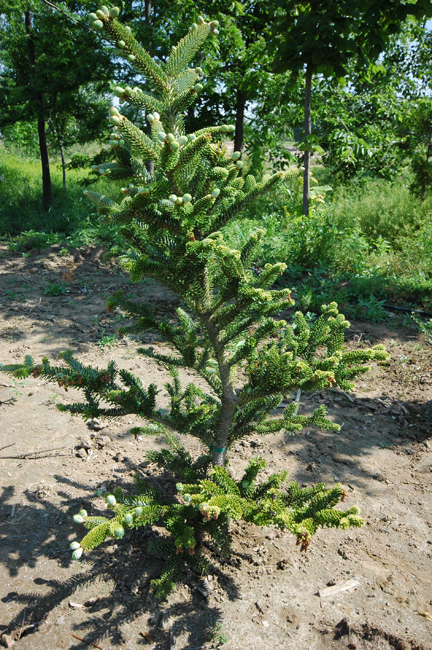| General Description | Branches at an upward angle to the stem with an open, loose overall form. The undersides of the leaves appear silver, with the tree a deep green. |
| ID Characteristic | The underside of the leaf has two white bands, the bark is pink grey in colour and the cones are purplish/violet when young. A very large, fat pyramidal plant that can get up to 8 m wide; fuller and larger than most firs. |
| Shape | Pyramidal. |
| Landscape | An outstanding specimen tree, with the branches tiered up the trunk of the tree. It is an incredible shape and has beautiful showy foliage. Not suited for wind breaks as it has a loose open form. |
| Propagation | Propagate by seed, which ripens in October. Seed in February, in a greenhouse or outdoors. Germination is typically poor. |
| Cultivation | Tolerates urban conditions and pollution. Prefers moist well-drained soil, does best in full sun. Wind tolerant but doesn’t like drying winter winds but prefers cool conditions. |
| Pests | Often damaged by deer, does not like highly alkaline soils. No serious insect or disease problems. It is tolerant to pollution when compared to most other Abies species. |
| Notable Specimens | Royal Botanical Gardens, Rock Garden Parking Lot (Area 7), Burlington, Ontario, Canada. |
| Habitat | Mountains of Japan. |
| Bark/Stem Description | Pink-grey bark that peels off in fine flakes. New bark is smooth with resin blisters. |
| Flower/Leaf Bud Description | Pale, yellow brown, shinny winter buds, conic or ovid-conic to 3 - 5 mm. |
| Leaf Description | Pectinate leaves that are densely arranged, pointing toward the branch tips, 1.5 - 3 cm long. Deep green in colour with two white stripes on the underside of the leaf. |
| Flower Description | Male stobili are ovoid, yellowish-green in colour. Stamen is dark purple, 1.4 cm long by 7 mm wide. |
| Fruit Description | Purple/ violet cones cover the tree, 10 cm long, standing upright on the branches. Often occur in clusters or rows along the branches. Cones are very resinous, turning brown as they ripen. |
| Colour Description | Deep green foliage, with pink-grey bark. The underside of the foliage has white strips making it appear to have a silver tinge. |
| Texture Description | Medium, shiny, leather-like foliage. |
